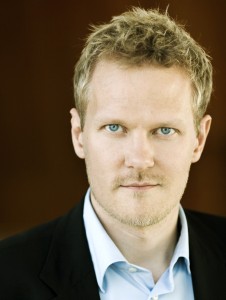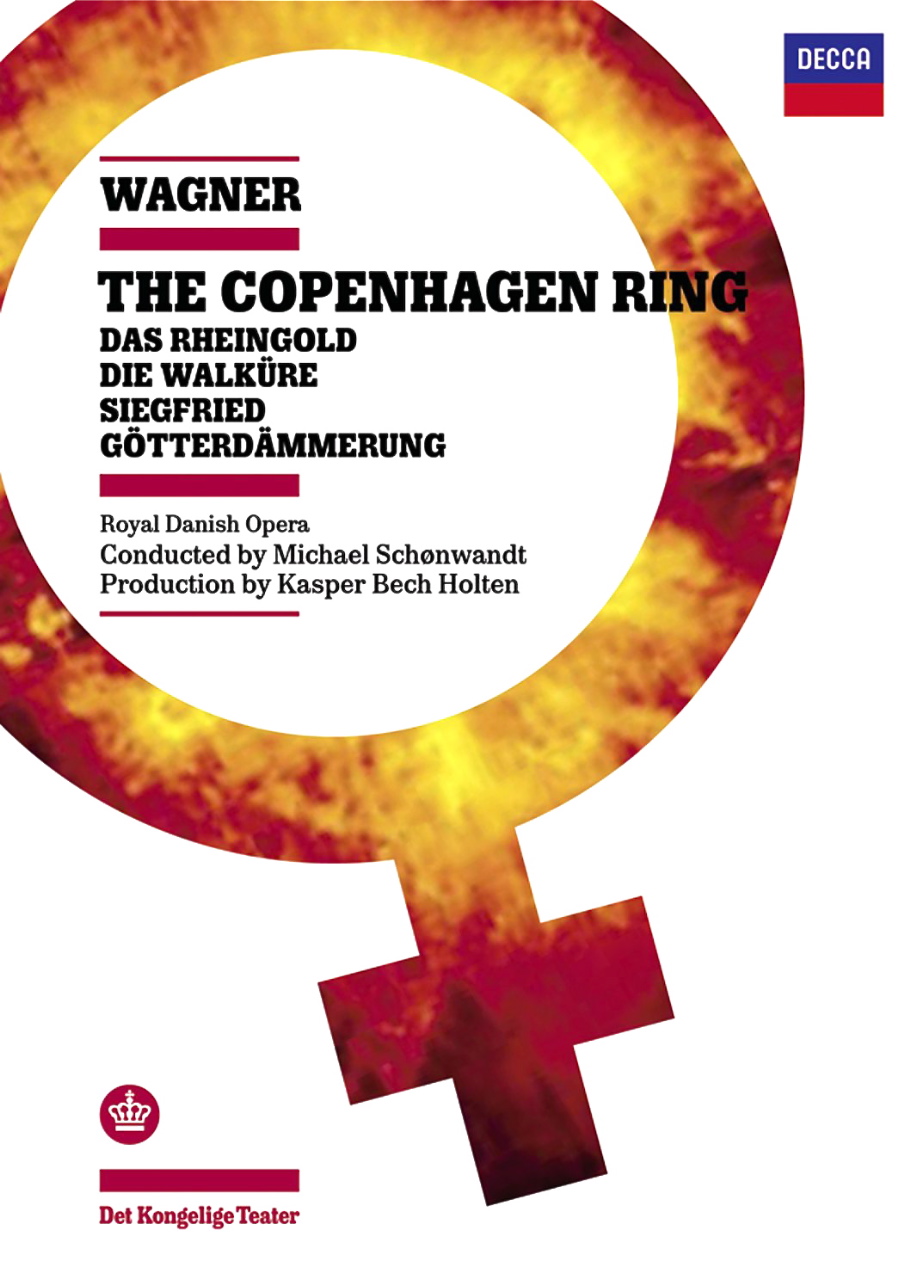A Daring Turn of the “Ring”
Wagner: Der Ring des Nibelungen (“The Copenhagen Ring”) Decca 0743264 (7- DVD set)
Half a century ago the first studio recording of Wagner’s Der Ring des Nibelungen was completed by the Decca label, a milestone of the catalog, produced by John Culshaw with Sir Georg Solti leading the Vienna Philharmonic Orchestra. A decade later, Pierre Boulez and director Patrice Chéreau scandalized Bayreuth with a centennial Ring that today remains a classic.
Now it’s the turn of a less prominent company to set a precedent with a daring rendition of this saga of sagas. Decca is again responsible for this new release, recorded in 2006 in the magnificent new home of the Royal Danish Opera on the Copenhagen waterfront. Unique and captivating, it is no wonder why it bears the title, “The Copenhagen Ring”.
A daunting Everest for every opera company, the Wagnerian epic has inspired a variety of approaches, many now on DVD: a traditional mounting from the Met with James Levine (which is being revived this month for the last time); two from Bayreuth (Boulez and Barenboim), Stuttgart (Zagrosek), Barcelona (de Billy) and Amsterdam (Haennchen). With the sets from Stockholm and Aix-en-Provence (Rattle and the Berlin Philharmonic) in the wings for possible future release — a remarkable Rattle Die Walküre is already out — this new arrival now takes the lead against its competitors.
Produced by Danish director Kasper Bech Holten (born in 1973 and current regent of the Royal Danish Opera) the Copenhagen Ring boasts an impressive cast of mainly local singers, reflecting the still- healthy Nordic Wagnerian tradition of Melchior, Flagstad and Nilsson. A first class orchestra splendidly conducted by Michael Schønwandt —the only Danish conductor to ever appear at Bayreuth — and brilliant stage design (Steffen Aarfing), costumes (Marie í Dalí) and lighting (Jesper Kongshaug), makes up the Wagnerian dream team that developed this stylish and provocative production.
 Holten (left) does in Copenhagen what his fellow Dane, Lars von Trier, did not dare in Bayreuth: upending the mammoth cycle and finding another turn of the Ring to create an instant classic: irreverent, irritating, controversial, even anti-Wagnerian. But also absorbing, poignant and unforgettable.
Holten (left) does in Copenhagen what his fellow Dane, Lars von Trier, did not dare in Bayreuth: upending the mammoth cycle and finding another turn of the Ring to create an instant classic: irreverent, irritating, controversial, even anti-Wagnerian. But also absorbing, poignant and unforgettable.
The saga is told in flashback from a feminine point of view. This is now Brünnhilde’s story, first Valkyrie, then earthly woman, whose Electra complex prevents her from escaping her father’s influence, encapsulated in the saga of her dysfunctional family – and what a family!
In the family library, she revisits her life to find what led her to this crisis. She examines and remembers, her memory, minimizing or magnifying events. She has betrayed the ones she loves, and desperately needs to understand her identity before it is too late.
Holten’s genius is a “Brünnhilde Ring” where the constant change and flexibility of the woman’s soul is the agent of change confronting the violent rigidity of masculine power. As the director puts it, “Along with Brünnhilde we journey through the 1920s and 1930s in Das Rheingold, in which the great ideological structures are raised, until we reach the 1950s in Die Walküre where the Cold War has frozen those structures into fortresses through which the great powers zealously guard each other in excruciating anticipation. Siegfried brings us to 1968 where the eponymous young hero naively rebels against his father’s rules and ideals until the fin-de-siècle joy he expresses in Götterdämmerung comes to an abrupt end in a clash with pure evil of the type seen in Bosnia or Rwanda.”
Purists will find many reasons to hate Holten’s conception, with the director simply changing situations or killing characters who are not supposed to die, and vice versa. He dares to change the finale to find a light at the end of the tunnel. The heroine’s racconto concludes watching in despair Siegfried’s death. Devastated, Brünnhilde decides to burn the past: the conflagration of the library igniting the final blaze of the universe. As a final rebellious gesture towards her father, she gives birth. Freed from the masculine yoke, redeemed as a mother, Brünnhilde redeems humanity.
Holten’s vision is a radical one, yet gives food for thought to audiences far removed from the habitual mindless Eurotrash Wagner stagings. Still, there are two instances where some might apply that term: Siegfried moments during the “Year of Love 1968” where the hero is a sex-drugs-and-rock-and-roll teenager, and in Götterdämmerung’s Norns scene, a Brechtian exercise that simply doesn’t work.
Still, the production offers much fresh insight and several coups de théâtre: Erda is a sort of Gloria Swanson living in a home for the elderly, the Valkyries are angels of death in gowns with real black feather wings, Loge is a chain-smoking gangster-bureaucrat á la Peter Lorre, the woodbird is a real white dove, the actual Rhinegold is a naked youth swimming in the pool of a cruise ship (the Titanic?), Alberich cruelly removes the heart of the Rhinegold, subsequently, a merciless Wotan (an alcoholic, drunk with power) tears Alberich’s arm to grab the ring, Wotan removes the divinity of his daughter tearing off her wings; the heroic couple are domestic middle-class conformists, while the tacky Gibichungs a corrupt Nouveau-Rich breed, emblems of late-twentieth century morals and aesthetics.
Like Chéreau before him, the prominence of human relations and close interplay between characters is a virtue of this theatrical adventure where infinite spaces (the divine) contrast with claustr ophobic ones (the human). Rich in metaphor— tragic, lyric, grand, even comic— it succeeds in making the sixteen hours of music seem incredibly short, an extraordinary achievement by all means.
Holten has the advantage of having great singers who are also deeply engaged actors. The superb first act of Die Walküre is proof of an unmistakable Ibsen-like feeling that pervades the whole approach, with two excellent Wotans: a young god for Rhinegold (Johan Reuter) and a mature one for the rest (James Johnson). Both Nibelungs are aptly detestable: Sten Byriel (Alberich) and Bengt-Ola Morgny (Mime). There is a temible, perfect Hunding by Stephen Milling, a five-star bass who also sings Fasolt. Reliable and indefatigable Heldentenor Stig Andresen plays both Siegfried and Siegmund (like father, like son). Gitta-Maria Sjöberg is a memorable Sieglinde and Randi Stene a commanding Fricka (resembling Hillary Clinton) yet it is Iréne Theorin who triumphs as Brünnhilde. At least on DVD, she sounds like the real thing, an opulent Hochdramatisch soprano in the mold of Nilsson. Her Immolation scene is breathtaking as is the unexpected finale. [NOTE: Due to Christine Brewer’s cancellation for the Met Ring performances due to a knee injury, Iréne Theorin will make her Met debut in the April 6 performance of Die Walküre, the April 11 Die Walküre and the April 18 performance of Siegfried.]
Another source of controversy is the way the Copenhagen Ring was filmed in the style of Dogme, the cinema movement started by von Trier and Vinterberg. Its extreme close-ups, weird camera angles and spontaneous out-of-focus glimpses can be annoying, but in the end it works as a gigantic mural. Tailoring it as a film is an ideal frame and statement of a production that according to Holten’s wish will not be repeated. As a bonus, the set includes a juicy conversation between the director and HM Queen Margrethe II of Denmark, an enthusiastic supporter of the project, who was clearly happy to see it staged.
Copenhagen has not seen a complete Ring since 1912. This brilliant realization was worth the wait.
Posted in CD/DVD
2 Responses to “A Daring Turn of the “Ring””
Leave a Comment
Fri Apr 3, 2009
at 1:12 pm
2 Comments

Posted Apr 06, 2009 at 1:10 pm by Andres Carrizo
Wonderful review. As someone who grew up with the Met/Levine’s Ring, I’m immediately excited to see Holten’s. The sheer bravado needed to change Wagner’s thick plot (what characters are killed off? how is the plot adjusted to fit the new setting?) sparks my curiosity.
Posted Apr 29, 2009 at 10:16 am by Bart
I just watched this on dvd, and it really moves you dramatically. I was constantly surprised by the dramatic choices, and I also laughed a lot during this Ring. It is really entertaining. The Met’s Ring, in contrast, is visually gorgeous but a little boring on the dramatic side of things. This Copenhagen Ring is true theatre and even laughs at itself by having the Norns as members of the audience holding a sign “No Regie Theater!” and pointing at Bech Holten’s picture in the program.